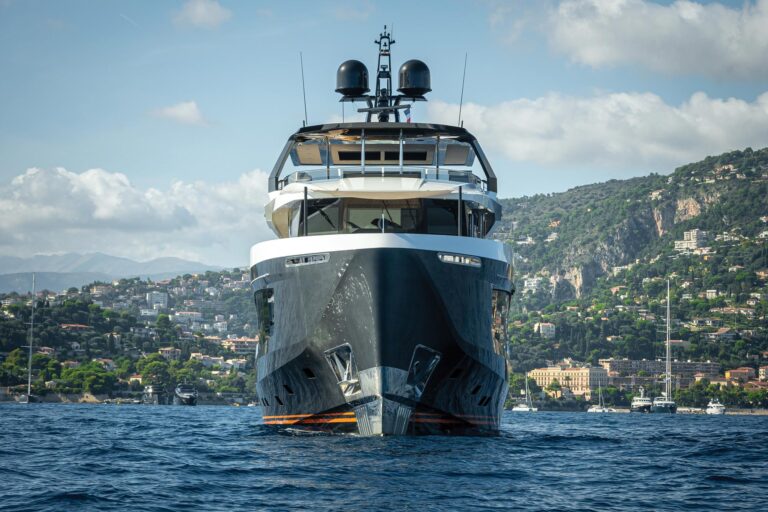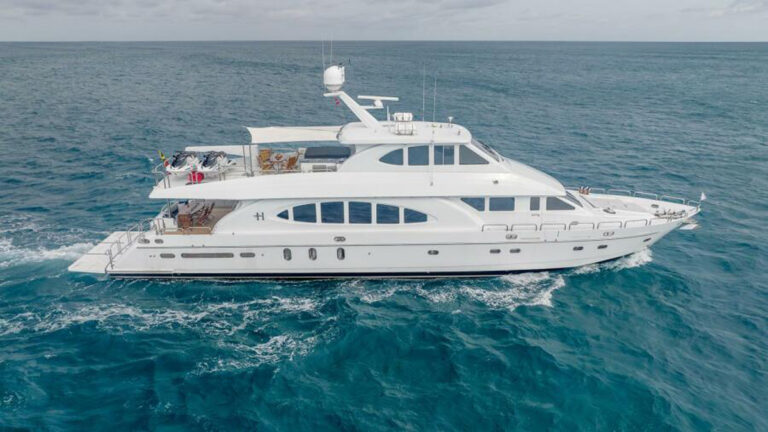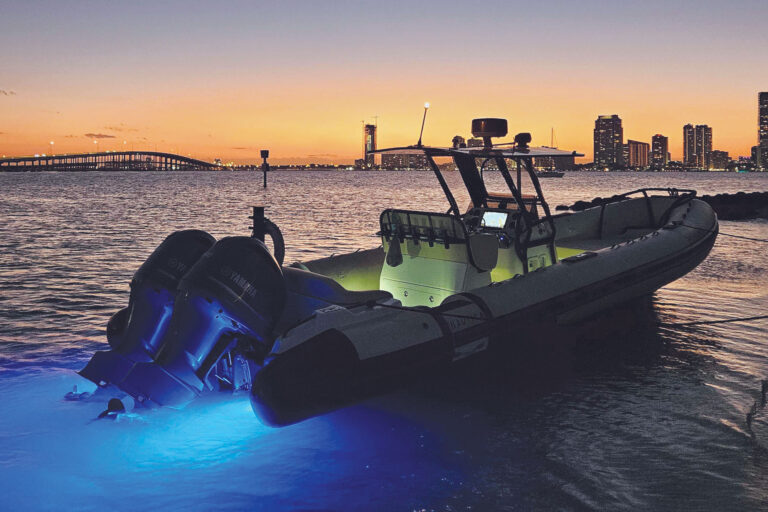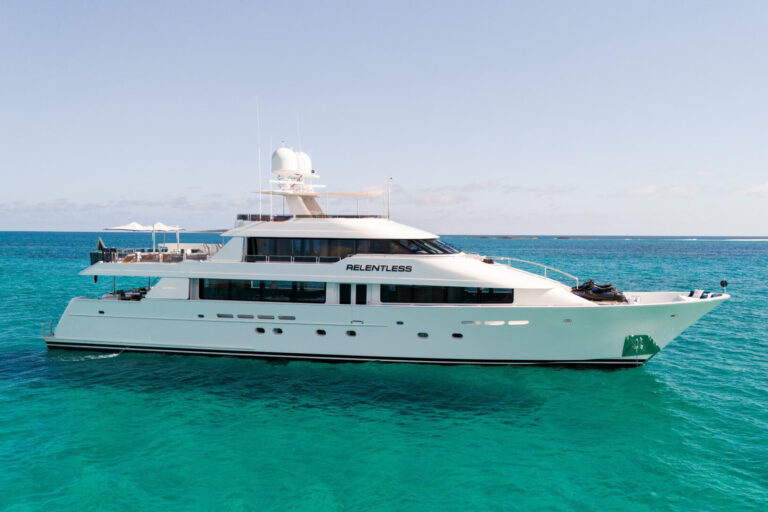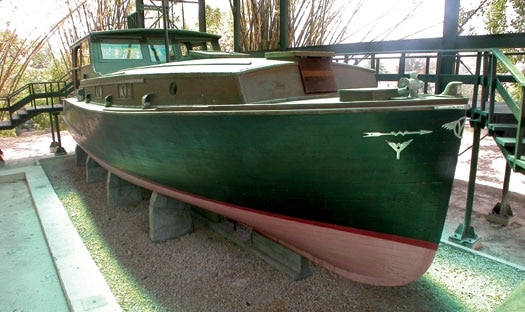
yachting/images/magazine/2005/072005/fea_pilar_525x312.jpg
Count the number of boats that have shaped our American identity. I count nine: Columbus’ Nina, Pinta and Santa Maria; the Pilgrims’ Mayflower; the U.S.S. Constitution or Old Ironsides; the schooner America; Joshua Slocum’s Spray; JFK’s PT-109. Then there’s Pilar.
If you had to stop and ask who, or what, is Pilar, don’t feel bad. You already know her-if you’re a boater, especially if you’re a sportfishing buff-and you owe her. Thanks to Pilar and her dashing owner, millions of Americans think nothing of spending a day, or week, or a life of weekends on the water. Thanks to Pilar, not a sports fisherman goes to sea without carrying on the legacy of the man who wrote the second most famous fishing story of all time. (The first? Moby-Dick, of course.)
Of all the boats above, only two still survive. Old Ironsides is still an active duty Naval vessel, berthed in Boston and open to the public. And Pilar, well, she’s in Cuba-like a prophet without honor in his own country-and therein hangs a tale worthy of “Papa” Ernest Hemingway himself.
Hemingway wrote, and Hemingway fished, at a time of profound transition for recreational boating. In prewar works such as To Have and Have Not (1937; the film in 1944), sportfishing was portrayed as a challenge both physical and spiritual-like bullfighting, like fly-fishing, like big-game shooting, all Hemingway subjects. As a doer and writer and celebrity, Hemingway dramatized boating and sportfishing, his picture appearing frequently in Life magazine, his face on the cover of Time encircled by a black marlin, his words echoed in all the publications of the time. Even the movie stars who played his characters-Humphrey Bogart in To Have and Have Not, Gary Cooper in For Whom the Bell Tolls, George C. Scott in Islands in the Stream-stood taller and walked with more authority for having played Hemingway men.
In fact, Ernest Hemingway was a founding father of sportfishing-a multibillion-dollar industry today-along with legends such as Charles Holder, Michael Lerner, Tommy Gifford, the writer Zane Grey and General George Patton. The International Game Fish Association includes Hemingway in its Hall of Fame, and his blurb contains a very Hem quote to the effect that anyone skilled enough to boat a 1,000-pound marlin should “enter unabashed into the presence of the very elder gods.”
Hemingway was an innovator who undertook a holistic approach toward the sport. He was an early adopter of outriggers (which were enormous and reported to handle up to 10-pound bait fish) and added a flying bridge with controls to his boat a few years after he bought her. He perfected his craft by listening to both native fisherman and top ichthyologists, with whom he shared observations. By all accounts, he was teacher, too, who tried to pass along his vast knowledge of fishing to many others. He was the first person ever to bring a giant tuna onto Bimini’s docks undamaged by sharks, a feat he accomplished by boating the fish before it tired and could be ripped into. This took skill and sheer strength, and thereafter the technique was called “Hemingwaying” a fish.
Thus Hemingway led us onto the waters (and to the mountains and streams as well). We went to sea to test ourselves in the wild, whether it was harnessing the wind for propulsion or trolling for great pelagics. All boating, at all levels, I am convinced, is driven by our desire to reconnect with nature and its wildness, to live “the strenuous life,” if only on weekends. And like “Papa,” we saw no harm in celebrating this primal connection at the end of the day with bottles of beer and strong spirits.
When our fathers and grandfathers were coming home from the Second World War, they were met with great prosperity-and the miracle of fiberglass. Suddenly boating was truly within the reach of all Americans, not just denizens of tony East Coast yachting communities. These new boating people, especially the sportfishing types-male and female-were a different breed. They wanted an honest boat that would take them where the fish were.
Consciously or not, these folks were and still are trolling in the wake of Hemingway, who in 1934 asked the Wheeler Shipyards of Brooklyn, New York, to build him a Playmate cabin cruiser with the following modifications: extra tankage so he could fish farther and longer, a transom lowered 12 inches for landing fish, a live fish well and an auxiliary inboard motor. Until I saw it myself, however, I was unaware of another quaint modification; Pilar has a wooden roller spanning her transom to ease fish into the cockpit; nowadays, no doubt, there would be a transom gate instead.
And there’s the rub: I saw Pilar, an opportunity denied to most Americans. On a hillside overlooking Havana and the sea, I went aboard Hemingway’s 38-foot yacht, which the Cuban government has on display on the tennis court of Hemingway’s former estate, Finca Vigia, now a museum dedicated to the legacy of the great 20th Century writer. There I had a chance to contemplate the Hemingway legacy and ask myself several disturbing questions: First, why can’t we pitch in and help to restore this boat? How did Hemingway end up losing his mojo as America’s most revered arbiter of the well-lived (read: sporting) life? Finally: Why don’t we love him as much as we should-as much as, say, the Cubans?
The short answers to the above are politics, a bitchy ex-wife and a jealous J. Edgar Hoover.
The Cuban Revolution occurred in 1959; a clinically depressed Hemingway blew his brains out in Idaho in July 1961. His widow left Pilar to Gregorio Fuentes, Hemingway’s beloved Cuban captain. Fuentes, turned Pilar over to the new Cuban government of Fidel Castro, then lived out his life in CojÌmar-Pilar’s Cuban homeport-until he died in 2002 at 104 years of age. He used to say that he missed his friend Ernest Hemingway every single day of his life. Because Pilar is in Cuba, the Bush administration has recently denied the attempt of a U.S. nonprofit foundation to offer technical assistance and financial aid, arguing that allowing the project to proceed would bring in tourism revenue that would bolster the regime of strongman Fidel Castro.
The truth, as I discovered, is that the Cuban government is losing money on keeping Finca Vigia and Pilar open to the public. Admission is a couple nickels per person, $2 per foreigner; there are about 70,000 visitors a year, most of them schoolchildren. Pilar is in good condition, given the circumstances of her outdoor display, but termites have gotten into her top deck and she badly needs a survey (see box).
Like dry rot in the deadwood, Hemingway’s shortcomings have also spread in the American public’s imagination. Earlier this year, a marine magazine described how, within months of America’s entry into World War II, Hemingway had obtained permission from the U.S. embassy to take Pilar on patrols along the north coast of Cuba, hunting U-boats. The magazine’s snide take: The patrols were a Hemingway scam to get around fuel rationing so he and his buddies could fish and drive drunk while ordinary people suffered wartime shortages.
Quite possibly this version originated in the remarks of Hemingway’s third wife, war correspondent Martha Gellhorn, who was souring on her life with Papa and could drink, smoke and shoot the bull with the best of them. She derided his patrols as somehow unworthy while the “real war” raged overseas.
Like a lot of Americans, Gellhorn failed to understand the strategic situation in 1942. The Japanese had just bombed Pearl Harbor; German submarines were winning the battle for Europe. Pilar’s fishing grounds were now teeming with a new pelagic species: predatory U-boats lying in wait for the tankers from Venezuela and the Gulf of Mexico. And their successes were staggering. In June and July, 30 ships were sunk near Cuba’s north coast and by November, U-boats had sunk 263 ships in the Caribbean Sea alone. Winston Churchill was apoplectic; he wrote President Roosevelt urging a more aggressive response, but we didn’t have the ships. Hemingway, who hated fascism, was undoubtedly inspired by the story of how British yachtsmen had helped evacuate their defeated army of 300,000 men from the beaches of Dunkirk in June 1940.
Knowing that Germans often stopped native fishermen for their catch and any fresh provisions and water they had on board their boats, Hemingway’s plan was to use Pilar as a Q-ship and meekly allow the U-Boat to come alongside, then suddenly spray the enemy deck crew with Tommy guns, while trying to toss grenades and satchel charges down the sub’s open hatch. As a plan it was a stretch, but naval history is full of successful asymmetrical deceptions, and I have no doubt the guy throwing the “frags” would have been the Basque jai alai player in Pilar’s crew.
Pilar’s patrols included one of more than 40 days along the cays of Cuba’s wild north coast. Nine men on a 38-foot boat for weeks on end should be no one’s idea of a lark, even if there was booze on board. One sub was sighted, but no action could be taken.
These would-be patriotic adventures earned Hemingway another detractor, one even more dangerous than a soon-to-be ex-wife: FBI director J. Edgar Hoover. Hemingway had also started and run a pickup spy network for the U.S. government, nicknamed the Crook Factory, which employed 20 agents and had a budget of about $1,000 a month. Having attracted Hoover’s enmity for For Whom the Bell Tolls, which condemned fascism before it became fashionable, Hemingway’s rival intelligence ring guaranteed that the FBI and Hoover would dog his heels for the rest of his life.
The man who inspired Americans to stand up against fascists and bullies, the man who urged us to establish a spiritual, mano a mano relationship with nature, the man who informed an entire generation of American boaters and fishermen-Hemingway deserved better treatment from the nation he served.
One way to honor the memory of Hemingway would be to help restore Pilar. Imagine her looking ready to once more land a 1,000-pound marlin. Papa Hemingway would like that.
Can Pilar Be Saved?-A Progress Report Dana Hewson is the Mystic Seaport’s vice president for watercraft preservation and would have been-and still hopes to be-the point man for Pilar’s restoration. Hewson visited Pilar in 2002 and found that the Cubans had done a workmanlike job preserving the boat. “I was trying to get as good a look as I could without banging her with a hammer or poking her with a knife,” Hewson said. “My take on her was that the restoration they had done was remarkable considering how poor the country is.”
To Hewson, the first step in further restoration would be a meticulous survey. “For one thing, termite damage, until it’s horrendous, isn’t visible from the outside. She looks to be in pretty good shape, but as any surveyor can tell you, there’s a lot that can show up. It could be that she just needs a good cosmetic paint and varnish job, or it could be she needs something more structural. There’s a lot I just don’t know.”
Even a cosmetic restoration would be hugely time consuming. I recently spoke to Massachusetts lawyer Hank Clark, who owns the only other 1934 Wheeler Playmate known to exist. He has spent 600 hours so far on cosmetic restoration of Valhalla. Such a labor of love, Hewson said, might cost up to $200,000 if done by an American boatyard-though if done in Cuba by Cubans, it would be much lower.
Finca Vigia is a “preservation emergency,” says executive director Mary-Jo Adams. “The roof leaks, the foundation is crumbling, the plaster is falling off the walls, the building has no adequate security, climate or environmental controls.”
The bottom line: The clock is ticking, but Pilar needs attention for the future.
HOW TO HELP
As Yachting goes to press, the Hemingway Preservation Foundation has enlisted the prestigious National Trust for Historic Preservation as a co-applicant, received bipartisan congressional support and submitted evidence that preserving Finca Vigia and Pilar will not substantially benefit the Cuban regime. Mystic Seaport would have a leading role in the Pilar restoration. Total projected costs are between $3.5 and $4.5 million.Tax-deductible contributions can be made to the Hemingway Preservation Foundation Inc., 60 Lloyd Street, Winchester, MA 01890. Contact: Mary-Jo Adams at (781) 729-0870 or mja@mjadams.org.





